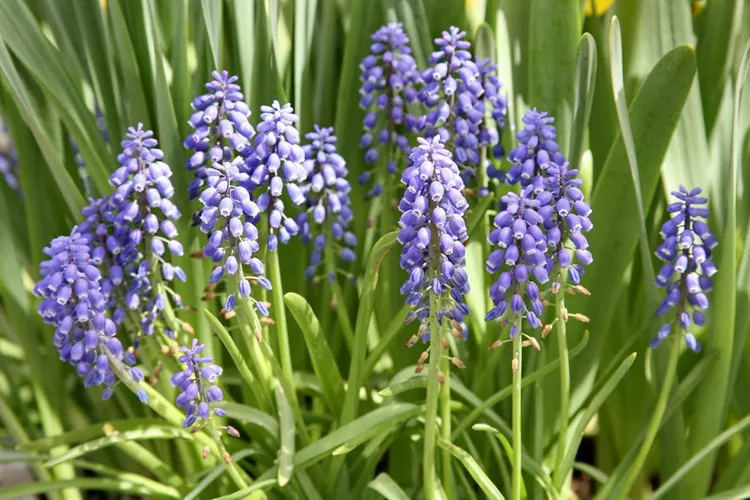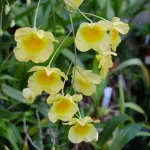Hyacinthoides non-scripta, commonly known as bluebell, is a beautiful flowering plant native to woodlands in Europe. Its captivating blue flowers, delicate structure, and sweet fragrance have made it a favorite among gardeners and nature enthusiasts alike. Beyond its aesthetic appeal, this plant holds rich symbolism and deep meanings across various cultures and contexts. This article explores the significance of Hyacinthoides non-scripta, delving into its symbolism, meanings, color significance, and interpretations in the realms of spirituality, love, tattoos, and even death.
Hyacinthoides non-scripta Flower Symbolism
Hyacinthoides non-scripta is often associated with a variety of meanings in different cultures. The flower symbolizes humility, gratitude, and the beauty of the natural world. In some traditions, it represents the transition from winter to spring, embodying renewal and hope. The gentle, nodding blossoms of bluebells evoke a sense of tranquility and peace, making them symbols of serenity and calmness.
Moreover, bluebells are linked to the concept of loyalty. Their ability to bloom in dense clusters signifies unity and connection among individuals. This makes them a popular choice for weddings and celebrations, symbolizing the bonds of love and friendship. In folklore, bluebells are sometimes said to be fairy flowers, representing the whimsical and enchanting aspects of nature. The symbolism of Hyacinthoides non-scripta thus encompasses a broad spectrum of meanings, from loyalty and humility to renewal and enchantment.
Hyacinthoides non-scripta Flower Meaning
The meaning of Hyacinthoides non-scripta extends beyond its physical attributes. The flower’s delicate, bell-shaped blooms signify humility and the beauty of simplicity. These flowers are often seen as a reminder to appreciate the small wonders of life and to remain grounded, no matter the circumstances.
In literature, bluebells have been used as metaphors for various emotions and situations. Their seasonal appearance heralds the arrival of spring, symbolizing new beginnings and the promise of growth. They also serve as a reminder of the passage of time, marking the transition between seasons and the cycles of life.
Moreover, in the context of personal relationships, bluebells can represent a deep connection and loyalty. Gifting someone bluebells can express appreciation and gratitude, making them a thoughtful choice for significant occasions, such as anniversaries or milestones.
Hyacinthoides non-scripta Flower Color Meaning
The predominant color of Hyacinthoides non-scripta is a stunning blue, which carries its own set of meanings and symbolism. Blue is often associated with calmness, stability, and tranquility. It evokes feelings of peace and serenity, making bluebells a fitting symbol for these emotions.
In addition to blue, Hyacinthoides non-scripta can also appear in shades of violet and white, each carrying its own significance. Violet, for instance, represents creativity and inspiration. It can symbolize the spiritual and mystical aspects of nature. White bluebells, although rare, symbolize purity and innocence, often evoking feelings of hope and renewal.
Overall, the color of Hyacinthoides non-scripta enhances its symbolic meanings. The calming blue tones encourage reflection and inner peace, while other colors broaden the flower’s significance to include creativity and purity.
See Also: Digitalis purpurea Symbolism and Meaning in Love, Death & Bible
Hyacinthoides non-scripta Flower Meaning in the Bible
In biblical contexts, flowers often carry deep spiritual meanings. While Hyacinthoides non-scripta is not explicitly mentioned in the Bible, the symbolism associated with bluebells aligns with various biblical themes. For instance, flowers in the Bible frequently symbolize God’s beauty and the transient nature of life.
The delicate bluebell can represent God’s creation and the beauty found in nature. Its seasonal bloom reflects the cycle of life, reminding us of both the fragility and the beauty of existence. The color blue is often associated with heaven and spirituality, linking bluebells to divine presence and serenity.
Moreover, the bluebell’s humble appearance resonates with biblical teachings on humility and gratitude. By appreciating the simple beauty of nature, individuals can find a deeper connection to their faith and a reminder of God’s blessings.
Hyacinthoides non-scripta Flower Meaning in Tattoos
Tattoos featuring Hyacinthoides non-scripta often symbolize various personal meanings, making them popular among those who wish to commemorate significant moments or emotions. The bluebell tattoo can represent loyalty, humility, and gratitude, reflecting the qualities one values in life.
People may choose bluebell tattoos to signify personal growth or transformation. As these flowers bloom in spring, they can symbolize new beginnings and the promise of renewal. This makes them an excellent choice for individuals who have experienced significant changes or challenges in their lives.
In addition, bluebell tattoos can serve as a reminder to appreciate the small things in life. Their delicate beauty can inspire a sense of mindfulness, encouraging individuals to cherish each moment and find joy in simplicity.
Hyacinthoides non-scripta Flower Meaning in Love
In the context of love, Hyacinthoides non-scripta carries profound meanings. The flower symbolizes deep connections, loyalty, and the appreciation of simple beauty in relationships. Gifting bluebells to a partner can express gratitude and affection, signifying the importance of the bond shared.
Bluebells also evoke feelings of tranquility and peace, making them a fitting symbol for harmonious relationships. Their gentle blooms can represent the serenity that love brings, encouraging couples to appreciate the calm moments together amidst life’s chaos.
Furthermore, bluebells can symbolize the beauty of friendship. In platonic relationships, these flowers serve as a reminder of the loyalty and connection shared between friends. This makes them a thoughtful gift for friends, symbolizing appreciation and the strength of their bond.
Hyacinthoides non-scripta Flower Meaning in Death
While death is often associated with darker emotions, Hyacinthoides non-scripta offers a more peaceful perspective. The flower’s gentle beauty can symbolize the cycle of life and the transition from one phase to another. In this context, bluebells can represent a serene acceptance of death and the continuation of life in a different form.
In some cultures, bluebells are used in funerals and memorials, symbolizing the beauty of the departed’s life. They can serve as a reminder to cherish memories and celebrate the life that was lived. The tranquility associated with bluebells can provide comfort to those mourning, encouraging them to find peace in their memories.
Moreover, the seasonal bloom of bluebells signifies renewal, even in the face of loss. This symbolism can offer hope to grieving individuals, reminding them that life continues and that new beginnings are possible even after difficult times.
Conclusion
Hyacinthoides non-scripta, or bluebell, is a flower rich in symbolism and meaning. Its delicate beauty and vibrant color evoke a sense of tranquility, making it a favorite among nature lovers and gardeners. The meanings associated with this flower encompass loyalty, humility, renewal, and the beauty of nature.
From its representation of new beginnings to its significance in love and friendship, the bluebell serves as a reminder of the connections we share with others and the importance of appreciating life’s simple moments. Its interpretations in spirituality, tattoos, and even death highlight its versatility and deep emotional resonance.
As we explore the world of Hyacinthoides non-scripta, we discover not only its beauty but also the profound messages it carries. This enchanting flower encourages us to embrace the beauty of life, cherish our relationships, and find peace in the cycles of existence. Whether used in gardens, bouquets, or tattoos, bluebells will always hold a special place in the hearts of those who appreciate their unique charm and the meanings they convey.
Related topics:













